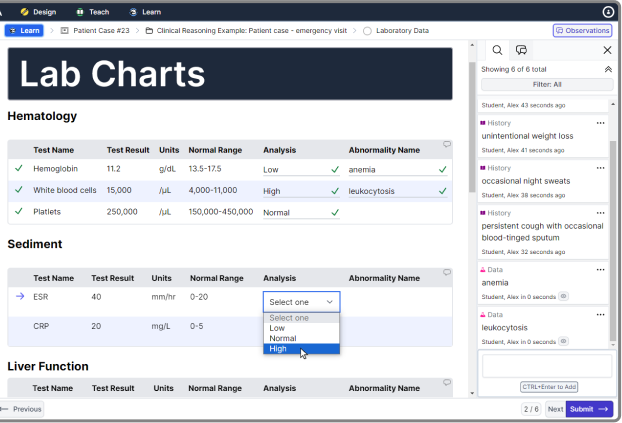Scale clinical and diagnostic reasoning in the classroom.
Students collect and synthesize patient data, determine relevance of observations, construct evidence-based diagnoses, and assemble management outcomes.
Why are universities choosing Allele for clinical reasoning?
-
Observe
Capture observations from patient history, signalment, and physical examinations.
-
Analyze
Analyze laboratory data results and identify abnormalities to be used in differential diagnoses.
-
Diagnose
Construct structured, diagnoses based on patient observations, and lab data analysis.
-
Compare
Compare student diagnostic reasoning directly against an expert’s diagnostic reasoning.
What makes Allele great for clinical reasoning?

Easy-to-build clinical reasoning cases

Structure ways of thinking in clinical situations

Visualize the diagnostic reasoning process

Scaffold cases to ramp up complexity

Manage and avoid student cognitive overload

Provide automated, formative feedback to students

Enable students to succeed without hating the process

Enable educators to succeed without hating the process
From novice to expert...
Link clinical reasoning cases together in a longitudinal format to increase complexity over time with a related set of patient cases.
What tools are Allele clients using for clinical reasoning?
By combining these tools and more, you can build impactful, simulated patient experiences to develop student clinical reasoning skills.
Plus, orchestration options to easily manage online, in-person, or hybrid classrooms.

You'll be sent a link to join and try Allele at absolutely no cost.
Integrate clinical reasoning into your curriculum.
Curricula is complex. Don’t get stuck with a system that supports only one of your teaching methods. Allele gives you and your peers the flexibility of pedagogy freedom.
Allele provides everything you need to build a strong curriculum foundation.
LMS integration
Integrate with your existing LMS for grade push-back, single sign-on, automatic account creation, and more. Create a future-proofed digital foundation with your LMS + Allele.
Collaboration at a click
Configure any activity to be taken as individuals or teams. In-app features support real-time student and teacher communication and collaboration.
Interactive authoring tools
Easily build interactive learning experiences with a modular, drag-and-drop toolkit. No computer science degree required. Build engaging course content in minutes.
360° reflection
Automate your reflection points into any course. Students can evaluate teammates, and themselves. Also allow students and educators to examine and peer review others’ work.
Powerful learning assessment
Provide students engaging opportunities to quantitatively and qualitatively assess their learning. Educators receive real-time student insights and aggregated analytics to view progress.
Curriculum scale
Broad, specialized sharing capabilities streamline collaboration and content iteration with peers. Preparing for subsequent semesters or additional sections is only a few clicks.


